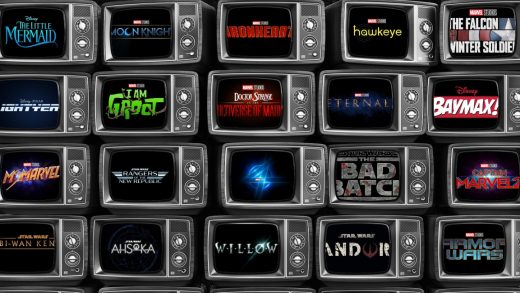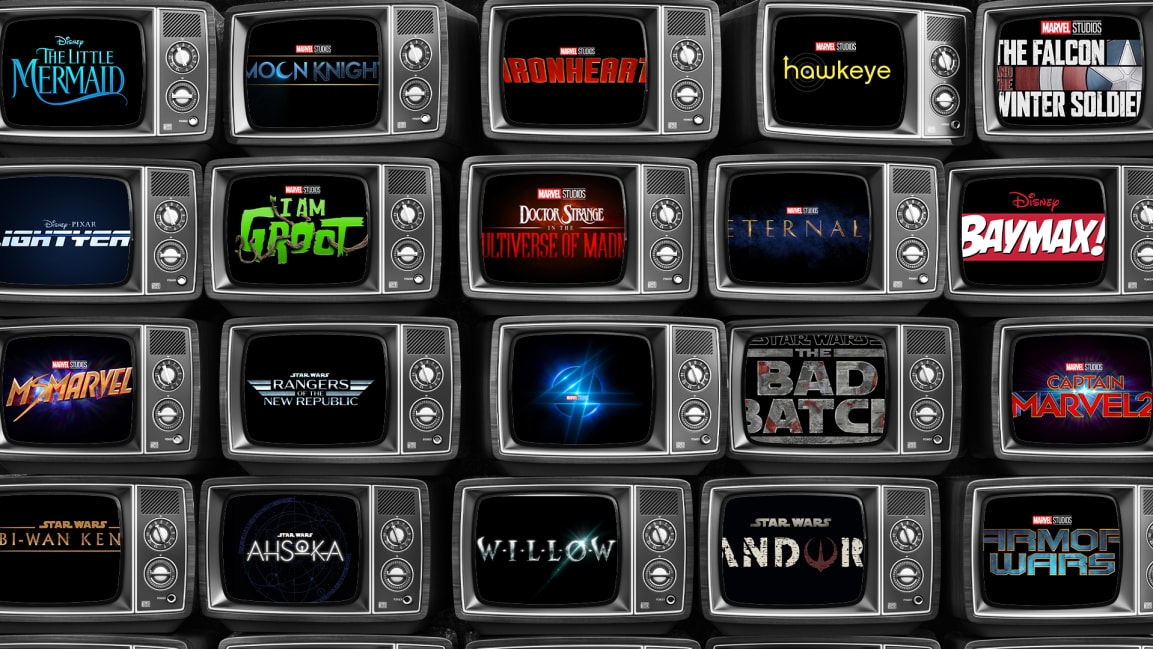6 reasons why Disney fans should be worried about its future
Disney’s Investor Day conference on December 10 was a four-plus-hour palooza during which the company wowed Wall Street—Disney’s stock soared 12% to $173.84 per share on Friday morning, an all-time high—and the media with its incredible outlay of product coming down the pipeline.
The content dump was nothing short of staggering, even in an era when Netflix has conditioned us to expect a fresh, new original program to pop up on our screen approximately every four minutes. Ten new Star Wars series! Ten more from Marvel! And so forth. By the time all the Disney execs and company heads had had a turn touting their wares—Lucasfilm’s Kathleen Kennedy, Marvel Studio’s Kevin Feige, Pixar’s Pete Docter, etc.—105 new movies and TV series were announced.
Even more newsworthy was that 80% of them are headed to Disney+, Disney’s streaming darling, which in just 13 months has racked up 87 million subscribers, making it Netflix’s most significant rival. Disney’s overall message was crystal clear: Disney+ is the future, as is making as much content as humanly possible to stock it with. (A few mentions were made of upcoming theatrical releases, but in dutiful service to its investor audience, streaming took up all the air in the room.)
Tucked deep into the fourth hour of the presentation, the company dropped a convenient “Oh, by the way”: The price of Disney+ is going up $1, to $7.99, starting in March 2021. FYI!
Investors may be cheering, but there are pitfalls within Disney’s growth plan. Here are six things you need to know about the future of Disney and Disney+.
1. Got a new, fresh idea? Don’t take it to Disney
Disney has spent the past decade-plus buying up some of the most valuable and iconic content companies in the world: Marvel, Lucasfilm, and Pixar. (Not to mention what it acquired when it bought 21st Century Fox.) Now that it has them in the fold, its main mission is to exploit the hell out of them.
The majority of “new” titles that Disney announced on Thursday were spin-offs of its most popular intellectual property. Two series based on Disney+’s breakout show The Mandalorian are in the works, and it was frankly too difficult to keep track of all the tertiary characters that are getting their own Marvel series, but among them are Hawkeye, Loki, Moon Knight, and She-Hulk. (She-Hulk’s status as a lawyer is accurate to the comics, but the presentation veered into self-parody when the show was pitched as a legal drama.)
This blueprint applies to every corner of the Disney empire. Coming from Pixar? A series based on Dug, the lovable pooch from Up whose thoughts are expressed via a robot-voiced collar. Then there’s Buzz Lightyear’s origin story (remember way back to June 2019 when Pixar executives said the company was focused on originals?) and a Lightning McQueen show. Milking IP is Hollywood 101 these days, but Disney is taking it to such extremes it’s hard not to wonder at what point do things start to feel a wee bit creatively bankrupt.
2. Everything and anything is content
In addition to the big-ticket stuff, Disney announced a collection of shorts, in some cases “mini shorts,” that will be debuting over the next year. Perhaps this is a way to test-run characters and stories, or perhaps—more cynically—it’s a way to load up Disney+ with cheap content that’s even more clickbait.
Either way, Pixar Popcorn was described as bite-size featurettes showcasing Pixar characters from Toy Story, Coco, Finding Dory, and beyond. Pixar is also launching something called SparkShorts, the first of which will be Burrow, a 2D short about a bunny trying to build the burrow of her dreams, that will launch alongside the feature film Soul later this month.
Meanwhile, Lucasfilm is debuting Star Wars: Visions, a series of animated short films by anime filmmakers celebrating the galaxy far, far away. The strategy seems to be to add as many titles as possible to Disney+ all in the name of “new content” to keep viewers watching.
It’s also, of course, yet another means of stretching IP to the limit and then some.
3. The verdict is out on theatrical
Many were waiting to see what Disney would say in terms of its upcoming theatrical releases, given the bombshell that WarnerMedia unleashed last week when it threw its entire 2021 movie slate onto HBO Max. But Disney kept things cool—and noncommittal—saying only that it was taking a “balanced” approach and that major titles like Black Widow and Rogue Squadron, a Star Wars film that Patty Jenkins is directing, remain destined for theaters.
Meanwhile, other projects, such as live-action versions of Pinocchio and Peter Pan & Wendy, are slated for Disney+. In some cases, as with the animated film Raya and the Last Dragon, films will be released in theaters and on Disney+, though streaming subscribers will have to pay an additional fee (akin to the Mulan release, which cost $30 on top of the monthly Plus subscription).
By not committing to any set-in-stone strategy, Disney is giving itself the freedom to adapt to uncertain times. Once the pandemic passes, it’s hard to imagine that the company will not return to a theatrical-first approach with its biggest titles, while moving less-expensive movies (or ones that don’t seem like surefire hits) over to streaming. But there was simply no way that Disney was going to wax on about the virtues of the theatrical business in a room full of investors who have become ravenous for movie studios to go all-in on chasing Netflix by abandoning all other preexisting (and still profitable) forms of distribution.
4. The artists are working for the factory
John “Peak TV” Landgraf, the highly respected programming executive who has led FX to great acclaim in the last decade, spoke eloquently about the quality and originality of shows that FX is making. But it was hard not to feel bad for the guy who pretty much singlehandedly grew FX into one of TV’s most blue-chip brands now that his job appears to be to churn out as much content as possible after he has spent years bemoaning the glut of shows vying for attention.
Indeed, it was hard not to guffaw when Landgraf said with a straight face that FX will be releasing 30 new original titles a year—or at least recall AT&T CEO John Stankey’s 2018 mandate to ramp up production at HBO in the name of streaming, an act that unceremoniously dropped the guillotine on HBO’s self-proclaimed “bespoke” culture of crafting masterful TV shows.
Pixar’s Docter seemed to be in a similar Where am I? situation as he ticked off an endless slew of new animated features and TV shows (and shorts) for Disney+, given Pixar’s hard-earned status as an artist-first studio that prides itself on its painstaking devotion to animation and storytelling. Remember when it “ramped up” to produce three movies every two years? (One original per year, and a sequel every other.) Welcome to Disney, boys!
5. Disney really does own everything
The general consensus coming out of Investor Day, even for veteran analysts for whom it was yet another trip to the rodeo, was: OMG. Not because the presentation itself was that great (it wasn’t; see below), but because the sheer volume of content that Disney is not only making, but owns the rights to, is staggering. As MoffettNathanson’s Michael Nathanson wrote in a research note, “While we expected to hear about Disney’s accelerated content investment in their DTC businesses, the sheer size and quality of the content tsunami headed to Disney+ was mind-blowing and frightening to any sub-scale company thinking about competing in the scripted entertainment space.”
Sure, there’s Star Wars and Marvel and every Disney animated character dating back to the Nine Old Men, the original Disney animators. But there are also so many franchises in so many different buckets it’s easier to just lay them out. All of these titles are getting some form of jazzed-up, sequelized/prequelized varnish in the coming years, after years of lying dormant in the Disney (or Fox) vaults: The Mighty Ducks; Turner & Hooch; Hocus Pocus; Three Men and a Baby (this one will have Zac Efron!); Ice Age; Night at the Museum; and more!
Should the term sequel fatigue simply be phased out at this point? Because this represents a push well past exhaustion.
6. Disney needs to work on its own storytelling
For a company that prides itself on telling stories, when Disney is tasked with telling its own, it falls flat. Beyond the excruciating length of Investor Day, the presentation was ponderous and lacking in any narrative flow. Early on in the show, a good 15 minutes was devoted to the rollout of its international streaming service, Star Plus, in Latin America. The “good” part didn’t come until more than an hour in, when finally Disney Chairman Bob Iger strolled out to talk about content.
But even the presentations about Star Wars and Marvel and FX felt like lectures struggling to straddle three key points:
Meanwhile, the vast majority of trailers and video reels weren’t available to viewers, who instead got mood boards with a countdown clock on them.
Note to Disney: Before the next one of these “events,” go talk to Apple.
(18)



